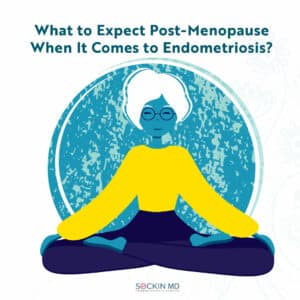What to Expect Post-Menopause When It Comes to Endometriosis?

Endometriosis is characterized by tissue resembling the endometrium (inner lining of the uterus) growing elsewhere, outside the uterus. This extra-uterine tissue responds to female hormones such as estrogen. But do symptoms of endometriosis continue post-menopause?
Does endometriosis continue post-menopause?
It is a myth that endometriosis only affects women of reproductive age. Research has shown that women as old as age 80 can experience endometriosis symptoms. Moreover, around 2 to 5% of those diagnosed with endometriosis are post-menopausal women. The most common site of menopausal endometriosis lesions is the ovaries.
However, endometriosis post-menopause is generally less active. Post-menopausal endometriosis is characterized by what is known as the “estrogen threshold”. Here, undetected or transient lesions can become active when there is a certain level of the hormone in the bloodstream.
Hormone replacement therapies (HRTs) that contain both progesterone and estrogen or estrogen-only that are used to treat the symptoms of menopause can also reactivate endometriosis lesions.
After menopause, adipose tissue is the primary source of estrogen production in the body. This estrogen can also reactivate endometriosis lesions.
Some researchers additionally think that post-menopausal women may have an immunosuppressive environment that can encourage the growth of endometriosis lesions.
How do doctors diagnose post-menopausal endometriosis?
Non-invasive techniques such as magnetic resonance imaging (MRI), 3D ultrasound, transvaginal sonography (TVS), computerized tomography (CT), and rectal endoscopic sonography (RES) can help with preliminary diagnosis, particularly with deep infiltrating endometriosis (DIE).
However, understanding the true nature of the lesion and reaching a confirmed diagnosis is only possible by laparoscopic deep excision surgery and the histological examination of the sample.
Is endometriosis post-menopause more dangerous?
Endometriosis lesions post-menopause may more likely occur as a neoplastic growth. About 0.7% to 1% of endometriosis can turn malignant. Endometriosis post-menopause presents a risk of recurrence and malignancy. The lesions may turn into clear cell or endometrioid ovarian cancers.
How to manage endometriosis post-menopause?
It is important to handle post-menopausal endometriosis cautiously. This is because there is a higher risk of malignancy than in a pre-menopausal woman. Your doctor should take a proper medical history to see if you have been undergoing hormonal therapy.
HRT should continue only after careful individualized evaluation. It is also important to keep in mind factors such as previous disease history, type of HRT, and risk of malignancy and recurrence.
Eventually, the only way to fully alleviate all endometriosis symptoms is laparoscopic deep excision surgery. The complete excision of all visible endometriosis lesions reduces the risks of recurrence and malignancy. Hysterectomy or oophorectomy might be necessary only in severe cases.
Do you still experience endometriosis symptoms post-menopause? Please share your story with others by leaving a comment on our post on Facebook or Instagram if you wish.
Get a Second Opinion
Our endometriosis specialists are dedicated to providing patients with expert care. Whether you have been diagnosed or are looking to find a doctor, they are ready to help.Our office is located on 872 Fifth Avenue New York, NY 10065.
You may call us at (646) 960-3080 or have your case reviewed by clicking here.